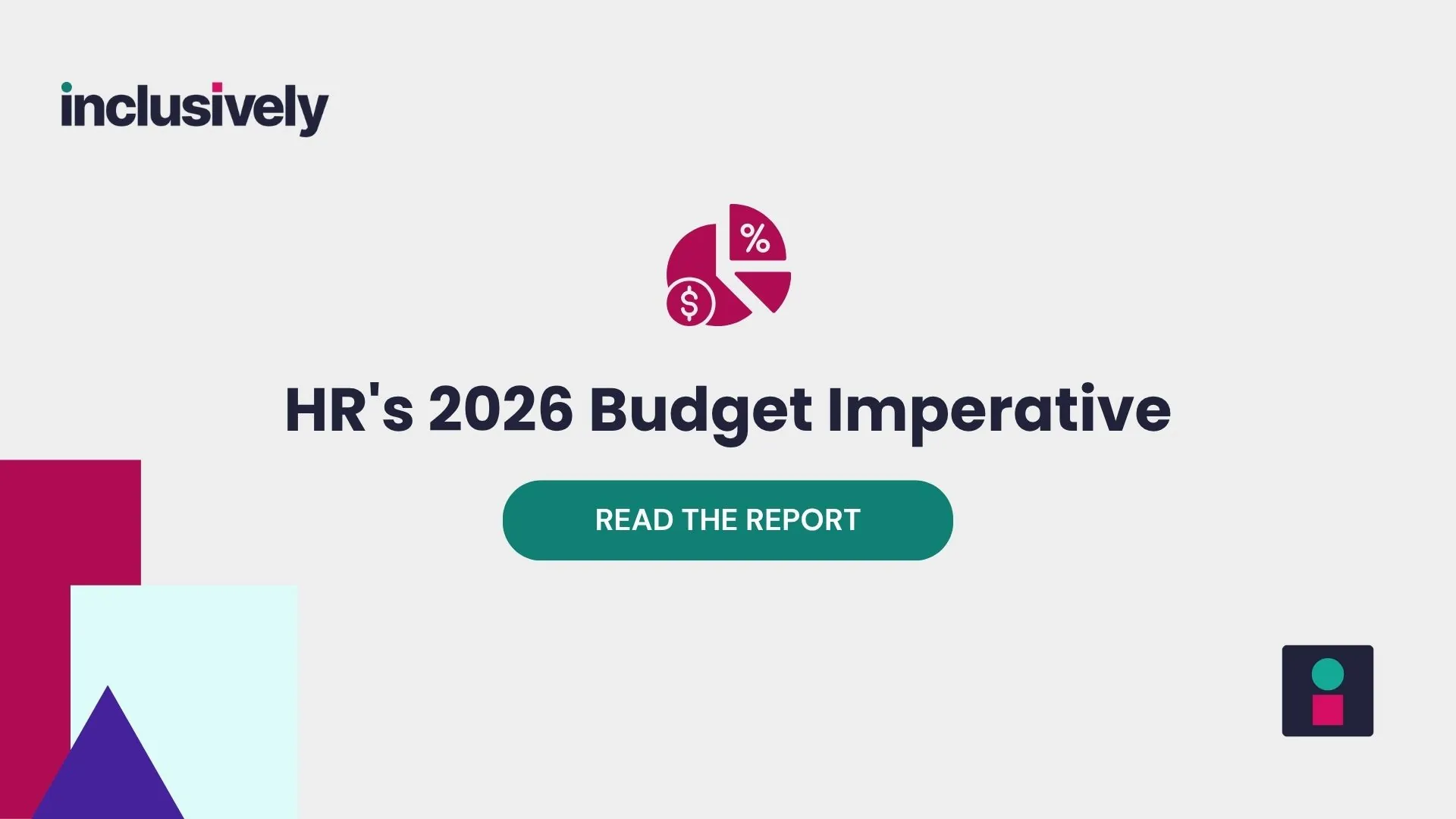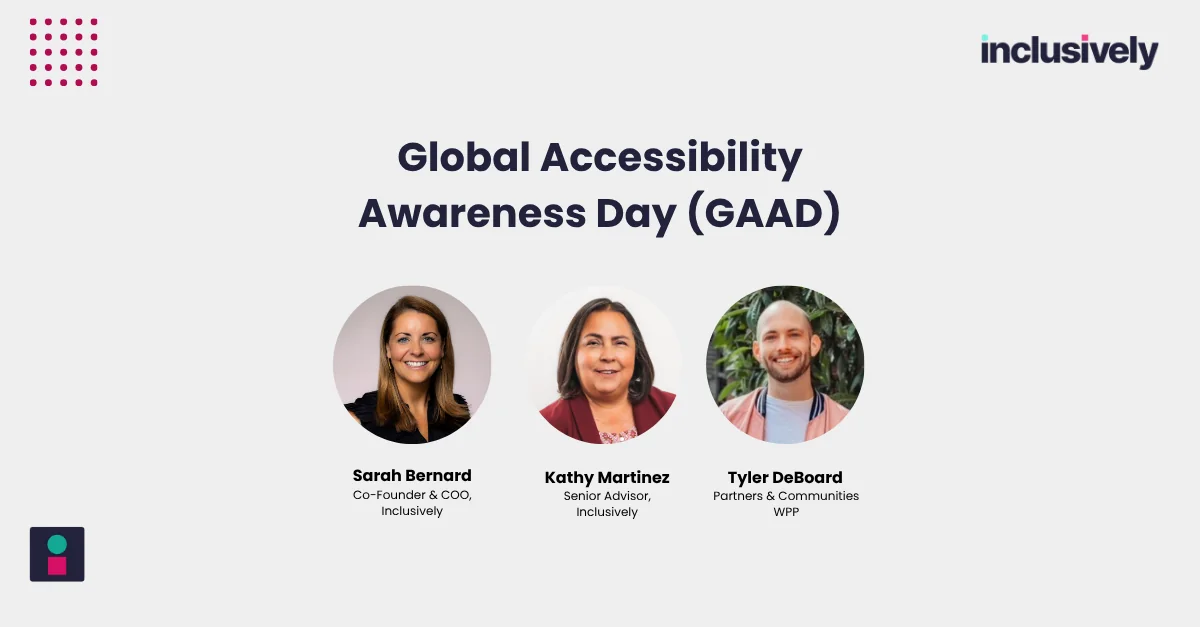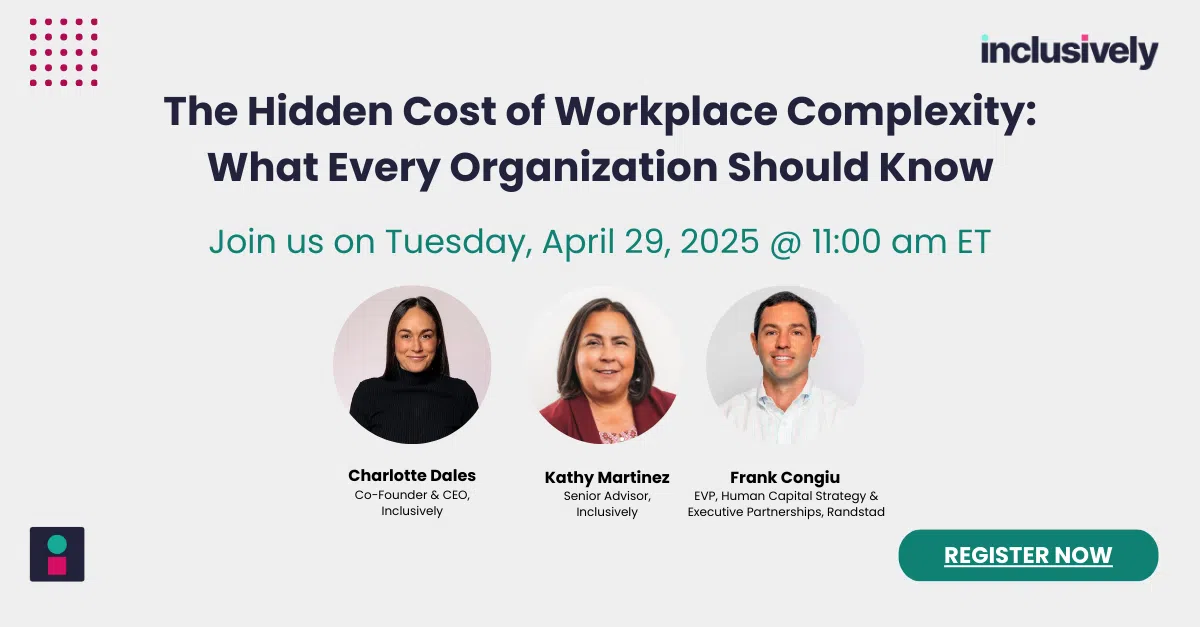Webinar
Normalizing Accommodations with Inclusively: Leveraging Al & Salesforce’s Expertise
Thank you for filling out our form. Please enjoy the webinar!
Webinar Transcript
Laura Beth Ezzell 0:02
Hello, everyone and welcome to today’s webinar, Normalizing Accommodations with Inclusively: Leveraging AI & Salesforce’s Expertise. We’re excited you could join us. My name is Laura Beth Ezzell, and I’ll be moderating today’s event. Now we are thrilled to be joined today by Inclusively’s co-founders, Sarah Bernard and Charlotte Dales, as well as Salesforce’s Disabilities at Work Senior Manager, Jessica Roth. Today, we are doing a deep dive on workforce productivity, retention, and inclusion. Specifically how these things can be increased at scale by AI, normalized and streamlined accommodations, and workplace personalization. We’ll also get an overview of Salesforce’s use case and the tactics and strategies they use to keep their workforce happy, productive, and inclusive. So let’s jump into it. Now to start, I want to talk about accommodations where we are with them. And where we’ve been, you know, it’s likely that most of our audience members know what accommodations are. But let’s set the context. You know, how have they been viewed in the past by companies? How are they viewed now? And what are the misconceptions about them? How do they fit into the current realities about work, Charlotte?
Charlotte Dales 1:43
So, yeah, thanks, Laura Beth. And it’s really great to be here and get to talk to everyone about this. I think to answer this question, it’s really important to start with the current state of the workforce. So a couple of weeks ago, Sarah and I got to go to Davos during the World Economic Forum. And the very first panel we went to was the CEO of HP who said that they recently commissioned a survey that found out that just 27% of knowledge workers feel they have a healthy relationship with work. And this continued to be a theme throughout the week. So the the words that the CEO actually used were, we’re managing our workforce in ways that are obsolete. And, you know, why are they obsolete, because the current for workforce now demands flexibility. And I know that many might say this younger generation have a lot of demands. But if you actually take into account why they grew up in a world where personalization has penetrated almost every aspect of their life, besides the place where they spend the most time, which is their jobs, and they also were growing up in an education system, where they were more frequently and earlier diagnosed and accommodated for things like mental health and learning disabilities. And these things don’t just go away after school. But fortunately, accommodations can really help solve for this. But there are so many misconceptions, as you just said about accommodations. People think they’re expensive, that it’s too complicated to implement them, that the payoff isn’t worth it, that only small slivers of the workforce are disabled. And I think the biggest one, which is that accommodations only help workers with disabilities. So the stats really refute these misconceptions, nearly half of the workplace accommodations out there cost nothing. If companies have the right tools and inclusive workplaces aren’t that hard to create. There’s, you know, a lot of people talk about this can of worms being open, but this this cans already open, people are already asking for things. And so what needs to happen is how do we optimize a framework and processes that already exists? So, you know, how do we use accommodations to make people more productive and more likely to stay at their jobs and not just those with disabilities? So we really have to shift people’s mindset from a medical model to a social model and accommodations with the right tools and processes around them can actually be a lever that helps make an entire workforce happier and more productive. And we’re going to get into the specifics of this during our presentation.
Laura Beth Ezzell 4:18
Yeah, thank you for that, Charlotte for setting that up for us. You know, that’s an important concept that accommodations are viewed one way but personalizing work across the board to help solve these really big workforce issues. So, Jessica, you know, how does this align with what you see at Salesforce?
Jessica Roth 4:46
Hello, everyone, thank you so much for having me here today. In my role at Salesforce, I lead the internal programs to enhance the experience for our employees with disabilities. Um, let’s just start by giving a little bit of background in the Office of Accessibility, which I have the honor to be a part of. The Office of Accessibility was created four years ago, really with the idea that we can enhance the experience of people with disabilities at Salesforce and create a truly equitable experience over our platform, our products and our employee base. My role at Salesforce really focuses on everything that’s internal to the employee experience. So what this really means is how can we create at Salesforce the most accessible, welcoming and inclusive environment where all employees with disabilities can show up and bring their best selves to work. So when I started in this role about about four years ago, now, what started to become very clear, after I started to really dig in and start doing this work is that it’s not just enough to offer accommodations to employees, what is really imperative to employees is making access layers, easily searchable for all of our employees. And I’ll go into this a little bit more on what this means in a bit as we keep on going. But what this really means is at a high level is a way for us to get feedback on what is worth paying and what not what is not working. As we all know when we apply for accommodation that is obviously confidential, especially you know, if you are submitting for a medical exemption. So if you’re in the Office of Accessibility, unfortunately, we don’t get insight into how people are liking the accommodation, is it something that we should double down on as an office to really improve and enhance the experience? Or is this maybe an accommodation that isn’t meeting the bar, and we should maybe scale back on so we can improve others. So prior to Retain, we really leaned heavily on our internal resource hub for employees to learn about benefits available, and what resources they can really get out of Salesforce, I do want to make mention that Salesforce is a 70,000 person global company. So sometimes it makes some of these resources that are fantastic at Salesforce, very, very hard to navigate, what we’ve learned is that employees don’t always know what they need in the workplace. So for example, an employee may really not know what their experience and how to best communicate that to our employee relations team who sets up the accommodations. So for example, an employee may think they know it’s really difficult to, to concentrate in an office setting, but they may not know how to find the resources that make managing their time in the in the workspace accessible. And if this employee specifically is not working from home, they really need some resources on figuring out how to make their office office environment more accessible for them. So outside of the searchability problem, we also had no way of measuring employee engagement. And I know I mentioned this earlier, as I’ve been speaking, but I really want to double down on how important that is, you know, again, as as someone who was working in the accessibility space, there is such confidentiality into accommodations. And just really having that aggregated data to understand what things are working for employees and why things aren’t working, really is imperative for us to continue to drive our mission. So I’m just switching gears here a little bit, I want to talk about our business resource group for people with disabilities and their allies called Abilityforce. This, this business resource group really gives us feedback in the Office of Accessibility on our programming, and really what what is happening in the community, we have a saying in the Office of Accessibility, that is nothing about us without us. So that is making sure that all of our employees with disabilities and our and our allies come along for the ride. So as I was mentioning, with our business resource group Abilityforce, we really have the opportunity to get some data onto what people are saying, you know, I think as part of the business resource group, people really trust the leaders in that group to go to to talk about what things are working for them, and what things aren’t working for them. But again, you know, this feedback is very quantitative. I can have a conversation with the President of our BRG and they will say you know, just that a lot of employees are saying that a software that we are using really isn’t hitting the mark. However, I can’t disclose the name of these employees are really specifics about what they’re saying but the employees don’t really seem happy. So why we’re really excited about the use of Retain is now we will have the opportunity to get qualitative data to understand again, what is working and what isn’t. And also, we’re excited that Retain will help us solve these pain points and improve our accommodation experience for employees to bring their full selves to work. As my goal in the Office of Accessibility and the Disabilities at Work Manager is for Salesforce to be the most inclusive environment for employees to show up, do their best work and have the greatest employment experience.
Laura Beth Ezzell 10:32
Okay, so we’ve gotten a look at the problem and how Salesforce is solving for it. So Sarah, what if I’m a chief executive, or an HR leader at another company, and I’m just now rolling up my sleeves? You know, productivity is an issue at my company. So as retention, managers are getting hit with accommodations request left and right, it feels overwhelming. What do I do, Sarah?
Sarah Bernard 11:03
So as an employer, you want to set your people up for success as much as possible. We know it doesn’t cost much as Charlotte shared and doing so raises productivity and retention. As we shared earlier, we heard from HP’s CEO that just 27% of workers have a healthy, satisfied relationship with work. That was shocking to me with how low it is. So here’s how I’d approach it. And again, this is based on the hundreds of conversations, we’ve had chief executives who are solving these problems at their large organizations. Right now, most people who need an accommodation, they have to disclose something extremely personal about themselves to their employer, it has to be pushed through the legal and compliance process. Sometimes that even requires a medical note, which can be really costly for an employee to get. And often employees, they don’t even know where to start when they do need support. And in the process, that they go through and involve the legal team, hiring managers, accommodations, teams, accessibility teams, sometimes outsource teams, none of this is automated whatsoever. But there’s another way to handle this. And that’s to create a scalable framework for accommodations, which we actually call Success Enablers at Inclusively, shifting from the reactive old way to a more proactive one. Be transparent about how you set this up to every employee, not just the employee who has disabilities. Ingrain this process and make it visible to all important employee lifecycle moments. For instance, at onboarding, be proactive and present the Success Enabler or accommodations process. Make sure that every employee knows where to start if they need support now, or for future reference. When an employee is having a performance issue, preempt this process, again, make the employee aware of where this framework lives. And then even if they move jobs preempt it then. This moves you away from the old reactive way of doing things that is based on a compliance and moves you to more a more social proactive model where all employees are brought along. But you need to maintain this framework and update it frequently. Connect the resources and investments that you’ve made to help employees bring their best selves to work to the accommodations framework that you set up. For instance, if an employee has an accommodation request for mentoring or coaching, and you already have BetterUp as a tool at your company, make it easy for that connection to be made that this service meets the accommodation. The framework should create a self serving opportunity that promotes education for employee accommodations. Oftentimes employees they don’t even know what accommodations can help them. So open that door for them to learn in a safe place. Don’t force them into a process where they have to disclose incredibly personal details about themselves if it’s just not necessary. Give employees the ability to share feedback. This is crucial in gaining trust with your employees. If you are getting feedback, you’ll know where to update this framework. This continuous feedback loop is going to help you chip away at this very unsettled tension that exists today between employees and their employers. On the administrative employer side, a lot of times they’ll get an accommodation request. But they don’t know how other companies are handling similar accommodations requested their companies, the employer is left to do all that research on their own. And oftentimes the resources are really limited. There’s no easy way to find the information that you need to help this employee and then apply it. And this creates a incredible time investment redundant conversations that take place. So create a place where administrators can also go and receive the employee accommodations request and quickly get the tangible information that they need to to fulfill it. If you build out this type of framework, you’ll minimize the redundancies that exist in your company today, and you’ll be able to handle way more at once. Your framework should be flexible, but you don’t need to be everything to everyone. However, you do need to collect data and have a pulse on employee satisfaction for this process. Use this framework to promote all the things that you’re doing for employee wellbeing. But you can also use it to iterate reiterate why your policies are set the way that they are. For instance, some companies, they just can’t have remote work for certain roles. And that’s okay. Leverage this framework to explain why, but show your employees everything that you’re doing instead. If you build the framework that we’ve just described, you’re creating flexibility, but with structure around it. This type of framework, it needs leadership support, and driving these initiatives. And the result should be a happier, more productive workforce for all.
Laura Beth Ezzell 15:56
That’s excellent. And you know, how does this help raise productivity across the organization, Charlotte?
Charlotte Dales 16:07
So, I think what people don’t really realize is that they actually have the foundation to raise productivity already, and it’s their current accommodations process in whatever form that is. Many of these processes out there already really, you know, they’re antiquated, and the architecture needs to be updated so that companies can create a wedge that dramatically increases productivity and retention. So as Sarah alluded to earlier, today’s process, it requires someone to self disclose personal information about themselves with pretty much no transparency on what the outcome will be. And this is why only about 3 to 5% of people choose to engage in this process, despite over 50% of people at companies being able to actually benefit from this process to make them more productive and less likely to leave. So we really believe at Inclusively that by adopting this centralized framework that solves for everyone at the company expanding its use case, you can turn your current Interactive Accommodations Process into a best in class, employee experience. So moving from a process that’s reactive and time consuming, time consuming, and generally unsatisfying for everyone involved to something that’s just proactive, seamless, efficient. And most importantly, for companies, it actually positively impacts your bottom line by increasing the productivity of your your workforce and also decreasing the costs that are associated with turnover.
Laura Beth Ezzell 17:41
Yeah, excellent points there. And how does AI fit into all of this? It’s, it’s all anyone’s talking about right now. Right, Sarah?
Sarah Bernard 17:49
So I’ll talk a little bit about how Inclusively uses AI to help employees find the right accommodations. Right now, people are so worried about bias being introduced into the world through AI but at Inclusively we’ve actually found a way to prevent bias with AI. Typical accommodations process today, it starts with self disclosure, as we’ve discussed. Someone has to say, hey, I have this disability or I have anxiety or I have this thing going on in my life and I need support. Our AI tool allows employees to get information about what support they can get, i.e. the accommodations or what we call Success Enablers, without having to disclose that personal information to a person. Which right now is an inflection point that bias is introduced. Our AI really becomes the Success Enabler expert that HR departments need to ensure that employees can do their jobs. You know, people fear the dangers that AI will introduce bias. But in this case, it’s actually quite the opposite. It helps prevent bias by allowing a bot to help a user anonymously get the workplace accommodations that they need without really exposing that information to the employer. At Davos, there wasn’t a single conversation had without AI being mentioned, it was the number one major theme. There’s a reframing around the narrative around AI. And it can actually help people become better at their jobs and remove redundancies. And our platform Retain is just one example. Retain automates an incredibly complex process that exists today at a company and the timing couldn’t be better with companies who are struggling with today’s workforce. You know, Charlotte alluded to the three major forces that contribute tailwinds to why companies can’t afford to do nothing. It’s the pandemic, people got used to working in a certain way that you know, for once they were all able to personalize their workplace when they were at home and they want to continue to do that. Millennials and Gen Z. As Charlotte mentioned, they’ve had everything personalized at their fingertips with the rapid rate, that technology has grown. And they expect people to personalize things that work because they can do it in every other aspect of life. And then also Millennials and Gen Z, they’ve grown up with so much support for learning disabilities and mental health and education system far more than in previous generations. And they’re needing and expecting that same type of support that they had in their school age years, and they’ll make up two thirds of the workforce by 2030. These demands are only going to increase and apply more pressure on companies to adopt a scalable solution. Leveraging AI is the only way that companies will keep up in the future. AI is speeding up the rate at which we can create tailored work experiences for everyone making them more productive, and likely to stay. But it’s not a free for all, you know, these processes, they actually create guardrails around flexibility that workers want so that everyone comes to the table, knowing what’s expected of them.
Jessica Roth 21:01
And then know Sarah, another thing I really want to call out on the platform is really, you know, you talked about the workforce and the amount of people that are going to be entering the workforce. And we all know at in part of the workforce, the number one person who sits at the receiving end of an application is a recruiter. And recruiters see a lot of applications yearly. I mean, at Salesforce alone in 2022, Salesforce saw 1 million applications during the fiscal year. So another use case that we’re finding with Retain is it gives recruiters the opportunity to talk about some of these access layers that we offer at Salesforce in just the beginning of a candidate conversation. I think, especially with the new generation, moving into the workforce, given that personalization that the recruiters can talk about and how this new generation can really bring their whole selves to work, really, I feel will set us apart from some of our competitors, where we’re really trying to recruit the best talent.
Laura Beth Ezzell 22:14
Yeah, great thoughts there from both of you. But when I asked the question, so what happens if executives and HR leaders don’t solve for these issues, Charlotte?
Charlotte Dales 22:32
So I think doing nothing really is a huge contributor to leading to quiet quitting and low productivity from your people. And doing nothing, even for just a little while can have dramatic effects on your business in the future. Another thing we heard a lot about at the World Economic Forum was how fast we move today compared to history. So if you think about it, it took about 10 years for email to become a ubiquitous solution at companies. However, in just 18 months, chat GPT came into our lives, and now is virtually part of everyone’s strategy. So the pace at which we evolve as humans, as an economy as a workforce is so fast. And for this problem, in particular, companies will be left behind really quickly in terms of quality and engagement of the talent if they don’t start building the foundation to meet the needs of this next generation of the workforce. So, you know, we’ve talked about this, but there’s just a really unsettled relationship between employees and employers right now. Gartner produced some research earlier this year saying that dealing with this situation is the top priority for execs and HR leaders this year, the suppose it can of worms has already been open. And I think finally, companies are now realizing that they can’t muscle work life back to the way it was pre-pandemic. So you can adapt though and create effective guardrails, around flexibility that make people excited about work and the things that you’re offering. Or you can do nothing but there’s a big cost to that people will quiet quit on you, others won’t be as engaged at work. Your most talented people, more importantly, will see this and lose morale. And your managers will become really burnt out with ad hoc requests that they don’t know how to handle and people just won’t stay. So for us, it’s really about how do we not only reduce this cost, but actually provide bottom line ROI to companies through the solution. And so adopting processes laid out in this presentation and if you need help with that, and the tools to do it, right, we can reach out to Inclusively.
Laura Beth Ezzell 24:49
Excellent. Well, we’re winding down here, so any closing thoughts? Jessica, we’ll start with you and then go to Sarah and Charlotte.
Jessica Roth 24:59
You know my I think my main closing thought is Charlotte’s last point was really what we wanted to avoid seeing at Salesforce, you know, we have seen some of this right with Return to Work people’s lives changing very dramatically than think, than how things were during the pandemic. So we really want you to be proactive in getting ahead of this. And that’s really the theme of the Office of Accessibility at Salesforce is for Salesforce to be able to support our employees with disabilities. And as important really continue to grow our employee base to become the most inclusive environment for candidates and employees with disabilities. One last closing thought that I wanted to leave you with is the external accessibility site at Salesforce where you will see a lot of our resources, you can visit us at www.salesforce.com, backslash accessibility. Thank you so much for having me here today.
Sarah Bernard 26:02
So keep mine short and sweet. Companies, they really don’t have a choice but to do something about this unsettled relationship between employers and employees. And it’s really not that hard to do find a scalable framework, make it transparent to all of your employees, not just your employees with disabilities, move this process outside of the legal and compliance forum and turn it into more of a social model. The organizations like Salesforce and some of our other clients who are doing this today, they are going to be the employer of choice of the future. Act now, and Jessica, thank you for joining us for this important discussion.
Charlotte Dales 26:44
And I think mine is probably expanding on Sarah’s but I think the most important thing I always try to reiterate to companies is that you do not have to be everything for everyone. You just need to try and figure out what are you comfortable with and go from there. That way you know both employers and employees can meet in the middle and there’s just a lot more transparency. And that’s what’s going to create a lot more trust that your employees feel that you are kind of working towards solutions, even if you’re not at the finish line yet. So yes, thank you again, Jessica, for joining us from Salesforce and to everyone who is listening. We are really grateful for your time.
Laura Beth Ezzell 27:26
Absolutely agree and this has been a great discussion. So thank you to our guest, Sarah Barnard, Charlotte Dales and Jessica Roth. I’m Laura Beth, goodbye to everyone and thank you for tuning in.

Sarah Bernard (She/Her/Hers)
Co-Founder & COO

Charlotte Dales (She/Hers)
Co-Founder & CEO

Jessica Roth
Salesforce's Disabilities @ Work Senior Manager, Office of Accessibility


